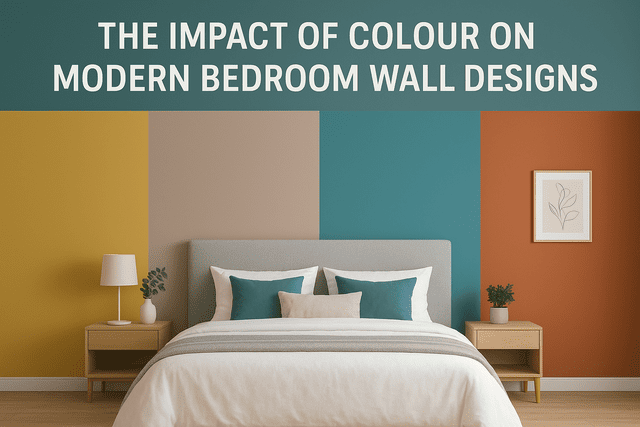
The Impact of Colour on Modern Bedroom Wall Designs
Step into any well-designed bedroom and you will feel it before you see it. Calm, cosy, or quietly luxurious, the mood begins with colour. In a modern bedroom wall design, colour sets the tone, guides the light, and helps your materials and textures look their best. Whether you paint, panel, or use bedroom tiles design, the shades you choose will shape how you sleep, wake, and unwind. Here is a simple guide to using colour with confidence.
Table of Content
- 1 Start With The Feeling You Want
- 2 Understand How Colours Behave
- 3 Light Changes Everything
- 4 Use Tiles To Add Colour And Texture
- 5 Pick A Palette That Works Hard
- 6 Decide Where Your Accent Lives
- 7 Match Finish To Mood
- 8 Think About Scale
- 9 Layer Texture For Comfort
- 10 Plan Your Lighting Around Colour
- 11 Keep It Cohesive With The Rest Of The Home
- 12 Simple Maintenance Tips
- 13 Conclusion
Start With The Feeling You Want
Ask one question first: how do you want the room to feel? Restful, romantic, fresh, or bold. Let that answer lead your palette.
- Calm and airy calls for soft neutrals and cool hues.
- Warm and cosy leans into earth tones and gentle pinks.
- Dramatic and hotel-like loves deep charcoals and navy.
Understand How Colours Behave
- Blue lowers visual noise. Pale blue or muted teal can help slow the room down and promote relaxation. Use mid-blues on a feature wall and lighter blues on the rest to avoid heaviness.
- Green refreshes. Sage, olive, or pistachio brings a garden-like calm. It pairs well with wood, rattan, and linen.
- Neutrals soothe. Greige, warm white, mushroom, and sand provide a clean base that complements almost any headboard or bedding.
- Warm shades embrace. Terracotta, clay, and blush add comfort without feeling loud when kept in muted tones.
- Dark tones add depth. Charcoal, indigo, and bottle green feel luxe, especially when paired with brass or walnut. Balance them with pale floors, bedding, or curtains.
Light Changes Everything
Natural light makes colours look brighter and cooler. North-facing rooms can appear blue, so opt for warmer neutrals. South-facing rooms can handle cooler shades of grey and blue. Always test swatches on two walls and inspect them in the morning and evening. A colour that glows at noon may feel dull at dusk.
Use Tiles To Add Colour And Texture
- Paint is not your only tool. A smart bedroom tiles design can lift the room while staying practical.
- Glossy ceramic tiles reflect light behind the side tables or as a small headboard panel.
- Matt porcelain tiles add a quiet, modern look with less glare. Consider large-format stone-look tiles in warm beige or soft grey.
- Wood look tiles bring warmth without the upkeep of timber and work as a half-height wainscot behind the bed.
- Subtle pattern tiles in herringbone, chevron, or fluted profiles add movement without busy prints.
- Keep grout close to the tile colour for a seamless look. In small rooms, fewer grout lines and larger tiles make walls feel wider.
Premium brands like Simpolo tiles and Bathwares offer a wide range of tiles to elevate the look of your modern bedroom wall design. Their premium-looking, durable tiles give a classy finish to your home, making them extraordinary.
Pick A Palette That Works Hard
- Try one of these easy three-colour plans.
- Cosy neutral: warm white walls, mushroom headboard wall, sand or oak-toned flooring.
- Fresh garden: sage feature wall, soft cream on the rest, natural wood furniture.
- Urban luxe: charcoal headboard wall, pale grey elsewhere, brushed brass lamps and off white bedding.
- Seaside calm: misty blue, crisp white trim, light beech tones for side tables and frames.
Decide Where Your Accent Lives
A feature wall behind the bed is classic because it frames the headboard and draws the eye. Keep it one or two shades darker than the other walls. If you prefer balance over drama, treat all walls the same and bring colour in through tiles behind the side lamps, a fabric headboard, cushions, and curtains.
Match Finish To Mood
Matt finishes looking soft and helps the walls recede. They hide minor imperfections and suit restful bedrooms. Satin adds a gentle lift where you want light bounce, like in a narrow room. High-gloss works best on small tiled areas, rather than full walls, to minimise glare.
Think About Scale
Small room. Light tones on most walls and a slightly darker headboard panel. Vertical lines in panelling or tile can make ceilings feel higher.
Large room. You can afford richer colours. Try a deep tone behind the bed and mid-tones on the other walls to keep it snug.
Low ceiling. Paint the ceiling the palest shade in your palette and continue the wall colour a few centimeters onto the ceiling to blur the line.
Long, narrow room. Darken the shorter wall to visually bring it forward and make the room feel more balanced.
Layer Texture For Comfort
Colour works best with texture. Pair smooth tiles with boucle or linen. Add a wool rug to the floor and deep, rich wall colours. Mix matte walls with a satin quilt for light play. Even a narrow ledge of stone looks tile behind the bed adds a quiet, architectural detail.
Plan Your Lighting Around Colour
Warm white bulbs soften cool palettes. Cool white bulbs sharpen warm palettes. Use two levels of light. A soft ceiling glow for general mood and focused bedside lights for reading. Wall washers across a textured or tiled headboard amplify depth without adding clutter.
Keep It Cohesive With The Rest Of The Home
If your hallway or living area leans towards a neutral tone, echo this in the bedroom by using the same warm white or pale grey. This link helps the whole home feel calm and considered. If you already have patterned floors, keep bedroom walls quieter and let textiles carry the accent colours.
Simple Maintenance Tips
Dust deep colours more often to keep them crisp. Wipe tile panels weekly with a soft cloth and mild cleaner. If your room receives intense sunlight, consider UV-protective curtains to shield rich pigments and fabric headboards. Premium suppliers like Simpolo Tiles and Bathwares offer tiles that are easy to clean and consistently provide a glossy finish. They are durable and give your bedroom a premium look.
Conclusion
A well-designed bedroom is achieved through the careful integration of colour, lighting, and texture. Defining the desired atmosphere at the outset, whether calm, welcoming, or energising, creates the foundation for every design decision. Chosen tones should be assessed in natural light to maintain consistency at different times of the day.
Finishes and surface treatments must then be selected to strengthen the intended mood while complementing the overall interior style. Introducing elements such as wall panels, textured surfaces, or subtle accent walls can add depth without disturbing balance.
When planned thoughtfully, a modern bedroom wall design not only elevates the aesthetic of the space but also supports relaxation, quality sleep, and overall comfort.


